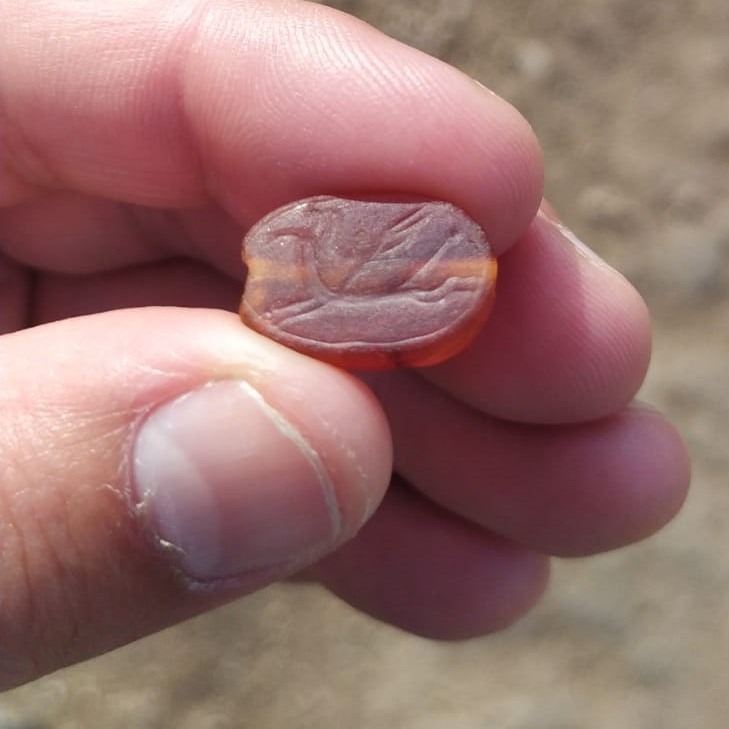IDF reservist finds 2,800-year-old Assyrian scarab amulet while hiking

The Israel Antiquities Authority recently announced a very rare discovery.
During a hike in the Nahal Tabor Nature Reserve in the Lower Galilee, a hiker stumbled upon a rare scarab amulet dating back to the First Temple period. The discovery was promptly turned over to the antiquities authority (IAA).
The scarab was discovered in Tel Rekhesh, a location associated with the ancient city of Anaharath on the border of the territory belonging to the Tribe of Issachar, according to Joshua 19:19.
Estimated to be around 2,800 years old, the beautiful scarab is crafted from reddish-brown carnelian stone and is believed to have originated either from Assyria or Babylonia. Carved in the shape of a beetle on the front, the back of the amulet features engravings depicting either a griffon or a winged horse, which are motifs commonly found during antiquity in the Ancient Near East.

The hiker, Erez Abrahamov (45) made this amazing discovery while on a two-day break from his military reserve duty, seizing the opportunity to enjoy a sunny day after the weeks-long rainy period that Israel experienced recently.
"I noticed something shining on the ground. Initially, I mistook it for a bead or an orange stone. Upon closer inspection, I recognized engravings resembling a beetle. Without hesitation, I notified the Antiquities Authority about this remarkable find," Abrahamov recounted.

Scarab seals, crafted into the shape of dung beetles from various stones, were a common feature in Pharaonic Egyptian civilization but were also prevalent across the world during antiquity.
According to the IAA, a scarab like the one Abrahamov found is quite uncommon because of its orange hue and the material it is made of. These types of seals were typically made from a softer blue stone and coated with a bright glaze, which mostly deteriorates over time.
Itzik Paz, an archaeologist affiliated with the IAA, highlighted the historical significance of Tel Rekhesh and noted the existence of a large citadel during the Assyrian dominion of the 6th and 7th centuries B.C.
"This rule, as we know, was responsible for the destruction of the Kingdom of Israel," Paz added.
The Kingdom of Judah was later destroyed and the elite, along with a large number of others, were sent to exile during the Babylonian conquest of 586 B.C.
Paz suggested the scarab that was found likely dates back to this era of Assyrian dominance and "might suggest the presence of Assyrian (or probably Babylonian) officials at Tel Rekhesh during this time."
He emphasized that If the scarab's age can be definitively determined and this association confirmed, it would constitute a discovery of "tremendous importance."
The scarab was likely unearthed by the recent strong rains, the IAA indicated.
"Every winter, with the onset of the rainy season, antiquities tend to surface and emerge," noted IAA Director Eli Escusido.
Abrahamov was awarded a certificate of good citizenship for acting according to Israeli law, which mandates the report and relinquishment of any discovered manmade object dating back to before 1700 A.D. or before to the authorities.
Escusido urged the public to adhere to Israel's Antiquities Law and emphasized the importance of reporting any archaeological discoveries directly to the Antiquities Authority while still in the field where the object was discovered.
"The precise location of an object's discovery holds immense significance... This unique scarab will be preserved in the state archives, facilitating further research and exploration," he said.

Aaron Goel-Angot is a Belgian-Israeli archaeologist with an expertise in antiquities identification. He is an enthusiastic numismatist and a licensed tour guide. He holds a BA degree in archaeology from the Institute of Archaeology at the Hebrew University of Jerusalem. He joined the ALL ISRAEL NEWS team as an Archaeology and Tourism correspondent. Aaron is married, father of three young children and lives in Jerusalem.














